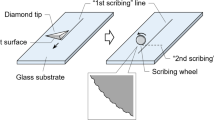Abstract
A simple robust “strut algorithm” is presented which, when given a graph embedded in 3D space, thickens its edges into solid struts. Various applications, crystallographic and sculptural, are shown in which smooth high-genus forms are the output. A toolbox of algorithmic techniques allow for a variety of novel, visually engaging forms that express a mathematical aesthetic. In sculptural examples, hyperbolic tessellations in the Poincaré plane are transformed in several ways to three-dimensional networks of edges embodied within a plausibly organic organization. By the use of different transformations and adjustable parameters in the algorithms, a variety of attractive forms result. The techniques produce watertight boundary representations that can be built with solid freeform fabrication equipment. The final physical output satisfies the “coolness criterion,” that passers by will pick them up and say “Wow, that’s cool!”
Similar content being viewed by others
References
Hart G W. The Geometric Aesthetic. Chapter 10, The Visual Mind II, Michele Emmer (ed.), MIT Press, 2005.
Hart G W. Solid-Segment Sculptures. Mathematics and Art, Claude Brute (ed.), Springer-Verlag, 2002.
Wells A F. Three Dimensional Nets and Polyhedra. Wiley, 1977.
Stephen T Hyde, Michael O’Keeffe, David M Proserpio. A short history of an elusive yet ubiquitous structure in chemistry, materials and mathematics. Angewandte Chemie, International Edition, 2008, 47(42): 7996–8000.
Anderson James. Hyperbolic Geometry. Springer, 1999.
Coxeter H S M. Non-Euclidean Geometry. 6th Edition, MAA, 1998.
Schattschneider D. Coxeter and the artists: Two way inspiration. The Coxeter Legacy: Reflections and Projections, Davis C, Ellis E W (eds.), Fields Institute Comm. Ser., 46, Amer. Math. Soc, 2005, pp.258–260.
Dunham D. Hyperbolic art and the poster pattern. 2003. http://www.mathaware.org/mam/03/essay1.html.
Knezevic I, Sazdanovic R, Vukmirovic S. Tess package for mathematica. http://library.wolfram.com/infocenter/MathSource/4540.
Hart G W. http://www.georgehart.com.
Author information
Authors and Affiliations
Corresponding author
Additional information
Portions of this material appeared in Proceedings of IEEE Solid Modeling International’08.
Rights and permissions
About this article
Cite this article
Hart, G.W. An Algorithm for Constructing 3D Struts. J. Comput. Sci. Technol. 24, 56–64 (2009). https://doi.org/10.1007/s11390-009-9202-y
Received:
Revised:
Published:
Issue Date:
DOI: https://doi.org/10.1007/s11390-009-9202-y




